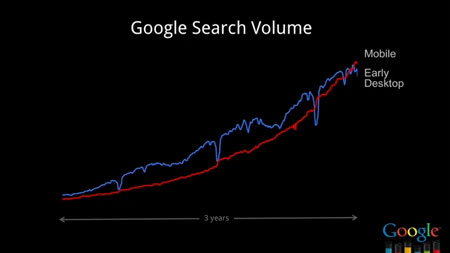Mobile SEO (Part 1 of 3)
If you don’t already know, this may come as a surprise to you. Google gives different search results to mobile phones than they do to desktop computers. Not only that, they will also serve search results based on the handset you are using. Lately, Google has been trying to algorithmically prioritize content that will work properly with the specific mobile device you are using. Google will also give lower priority to content that probably won’t work well on your specific mobile device.
Just look at the explosion of mobile search and how it’s adoption mimics that of desktop search over a 3 year period:

Now, with Google implementing their new smartphone crawler, mobile SEO is changing and people and companies are going to have to adapt if they want their mobile site to be successful.

With Google launching their new smartphone crawler, a study was done that determined how the top sites in the United States are handling their mobile site traffic. The sites were divided into 3 groups based on how they were publishing their mobile pages. The 3 types were server-side redirection, JavaScript redirection, and “cloaking” or selective serving of HTML assets. About 52% used server-side redirection, around 2% used JavaScript redirection, and about 45% used cloaking or dynamic serving. Remember, all these sites were the ones that showed without errors.
Server-side redirection is a mobile site strategy that uses two or more URLs. One is used for the desktop site, and one is used for the mobile site. The reason more than two is sometimes used is because designations can be added for tablets, WAP, and other mobile devices. The mobile site content’s ability to rank on the search results can depend on whether the mobile content is on a subdomain, a mobile directory, or a completely different domain. The mobile URLs can be static and optimized URLs, or they can be temporary dynamic URLs. Temporary dynamic URLs are usually crammed with the precise constraints of the mobile page request.
Traditionally, mobile SEO strategists relied on the rankings of desktop pages which would automatically redirect end users to mobile content whenever requested by a mobile phone. Another method they used was building independent SEO value for mobile pages so that they would rank on their own value, not the desktop pages’. This would sometimes include merging the mobile pages with the desktop pages by using the canonical tag to help share SEO value. However, the most important thing to remember is to allow both pages the ability to be crawled by search engines. This can be important for two reasons. The first is if you target a lot of WAP phone searches; they are still using a separate “mobile-only” Google index so they are not affected by the new smartphone crawler. The second reason you want your pages to be crawled is if there’s another algorithm shift in the future to where a stronger emphasis is put on mobile file size. All of this is important for a good end user mobile experience. The important thing to remember from all this is that 52% of the top million websites who use this method will probably benefit from Google’s new crawler.
The next way to publish a mobile page is through JavaScript redirection. This involves a primary and mobile URL for each page. On-page JavaScript redirect is included from the desktop page to the mobile page. The irony of this method is that the JavaScript literally depends on the failure of search engines to crawl and execute the JavaScript for it to work correctly. Usually, this method relies entirely on the desktop site to rank well in smartphone searches, while the mobile pages are blocked from search engines cataloging in the robots.txt file. This prevents any chance of replication or disorder in the catalog. Sometimes, the JavaScript is detecting particular phones and redirecting them to landing pages that are built specifically for those particular phones. This can become very tedious, but the end result is great for your end users. However, unless Google’s new crawler learns to perform JavaScript redirects, and this is highly unlikely, sites that use JavaScript will not gain anything from Google’s new smartphone crawler. In fact, as mentioned earlier, only 2% of the top million sites used this method successfully.
The third way to publish a mobile site is with cloaking or dynamic serving. This is dependent solely on one URL that can display, depending on the device that requested the page, a page with different characteristics. The content provided is decided by the server and what is usually described as a “transcoder” or “mobilization engine.” Fundamentally, this is a database of content and rules that are in various sizes and stages of regression that can be sent to phones depending on the specific phone requesting the information. Using this, a desktop computer would get the full version of the site, but a mobile device will get a comparable HTML skin. However, the mobile version of the site will have smaller elements switched in to replace the larger elements on the desktop site. All of this would be on the same URL. Note that about 45% of companies who used this style of mobile site were successful.
The bottom line is that mobile SEO is indisputably changing, yet the search engines can’t seem to agree on how to best rank and evaluate search results. The most successful people in the industry have a knack for always knowing how things work by staying up to date on how their own sites are faring and conducting their own mobile experiments. However, because of the new Google smartphone crawler, it is not enough to just test on your own phone anymore. Companies are going to have to learn to change and adapt if they want to optimize their mobile search results. Otherwise they will just get lost with all the other companies who don’t know how to optimize mobile search results.
Despite all the information we just gave you, this is just the tip of the iceberg. We will be publishing parts 2 and 3 concerning Google’s new smartphone crawler over the course of the next week.








Leave a Reply
Want to join the discussion?Feel free to contribute!